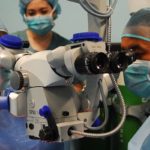1. In this prospective cohort study, the mortality rate in community-living older persons in the United States following major surgery within one year was 13.4%.
2. Age 90 or above, frailty, and probable dementia were associated with significantly increased one-year mortality rates in community-living older adults following major surgery.
Evidence Rating Level: 2 (Good)
With the aging population in the United States (US), the number of older persons requiring major surgery will also continue to increase. In the geriatric population, priorities for outcomes include preserving functional independence, maintaining health-related quality of life, and relieving symptom burden. Population-based mortality, while imperfect, is a good indicator of the welfare of older persons and will allow us to better understand the scope and scale of mortality after major geriatric surgery. Current estimates of mortality following major geriatric surgery lack important aspects of information including longer follow-up or meaningful geriatric-specific conditions such as frailty or dementia. The objective of this study is to calculate population-based estimates for 1-year mortality following major surgery in community living older US adults and to determine the effect of key demographics. Data were extracted from the National Health and Aging Trends Study (NHATS) linked to records from the Centers for Medicare and Medicaid Services (CMS). Included were community-living patients 65 years or older undergoing major surgery, which was defined as a procedure needing use for general anesthesia for a non-percutaneous non-endoscopic intervention. Major surgeries were included from 2011 through to 2017, and important information was collected such as frailty index (stratified into non-frail, prefrail, and frail) and the presence of dementia. 1,193 major surgeries were included in the analysis, and over one year, there were 206 deaths representing 13.4% mortality. With respect to age stratification, increased mortality was directly associated with increased age, with statistical significance between those aged 65 – 69 and those in the 3 oldest age groups. Furthermore, with respect to sex, men had higher mortality than women, but the findings were not statistically significant. With respect to frailty, mortality was highest in those defined as frail and lowest for those defined as non-frail; the mortality rate was significantly higher in patients defined as prefrail when compared to non-frail (HR 1.94, 95% CI [1.01, 3.73]) and significantly higher in non-frail versus frail (HR 5.31, 95% CI [2.61, 9.39]). In addition, mortality was significantly higher in those with probable dementia when compared to those with no dementia (HR 3.29, 95% CI [2.08, 5.19]). Overall, the findings from this study suggest a high mortality rate of community-living older adults in the US within one year following major surgery. Within subgroups, there are substantial differences in one-year mortality which highlights the prognostic value of age and geriatric conditions such as frailty and dementia. A major limitation of this study is that it only included fee-for-service Medicare beneficiaries, with a penetrance of approximately 25%. In addition, the only measured outcome was mortality, but especially in the geriatric population, additional outcomes such as functional status, quality of life, and days spent at home should be considered as well. This study contributes possible prognostic factors for mortality in older persons following major surgery, and further research into specific risk factors may guide decision-making regarding major surgeries in this patient population in the future.
Image: PD
©2022 2 Minute Medicine, Inc. All rights reserved. No works may be reproduced without expressed written consent from 2 Minute Medicine, Inc. Inquire about licensing here. No article should be construed as medical advice and is not intended as such by the authors or by 2 Minute Medicine, Inc.


